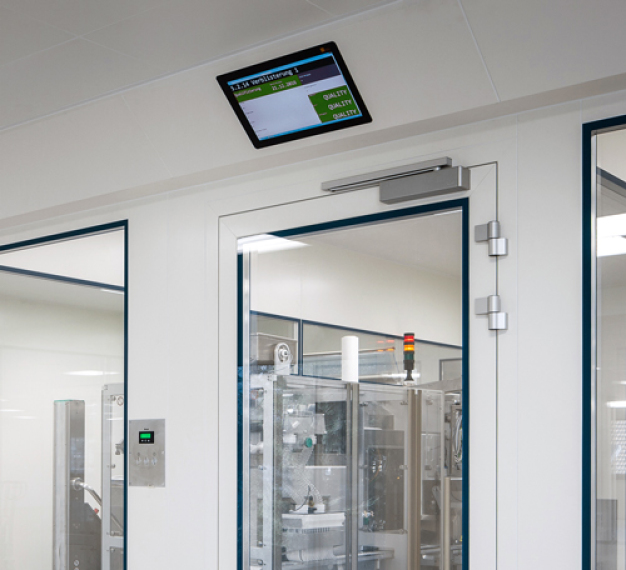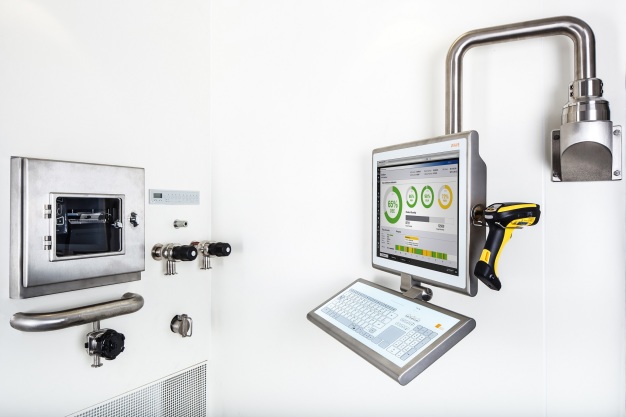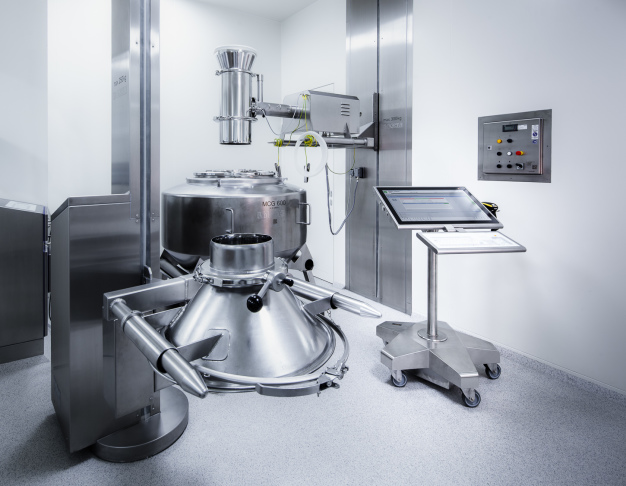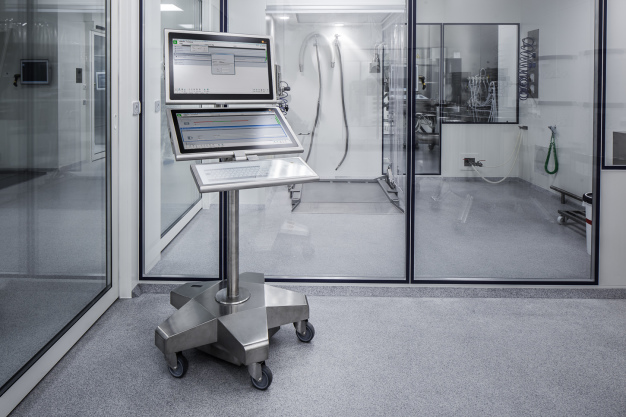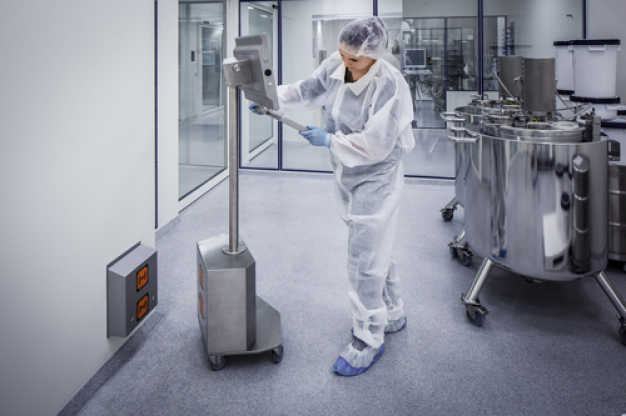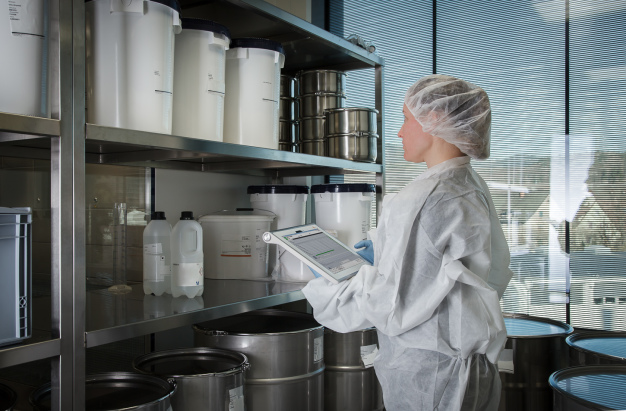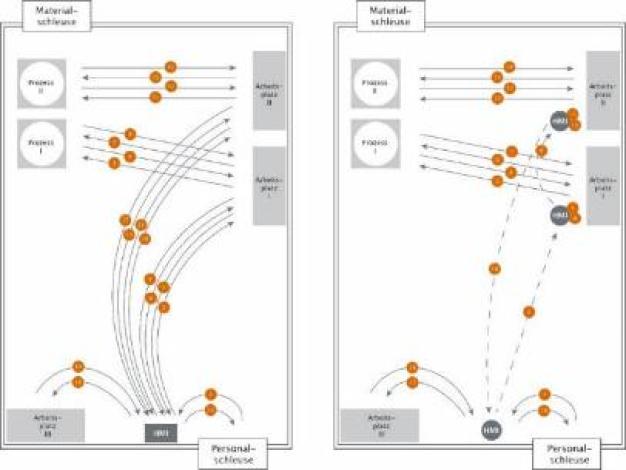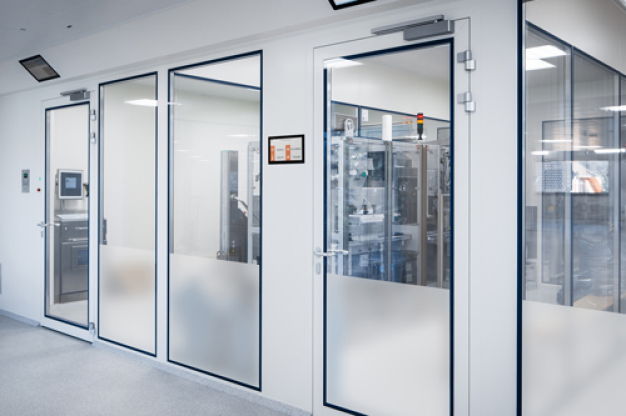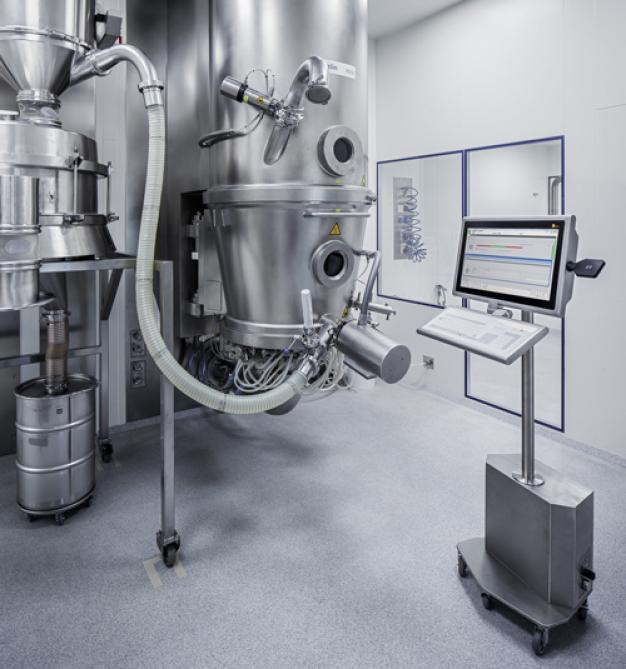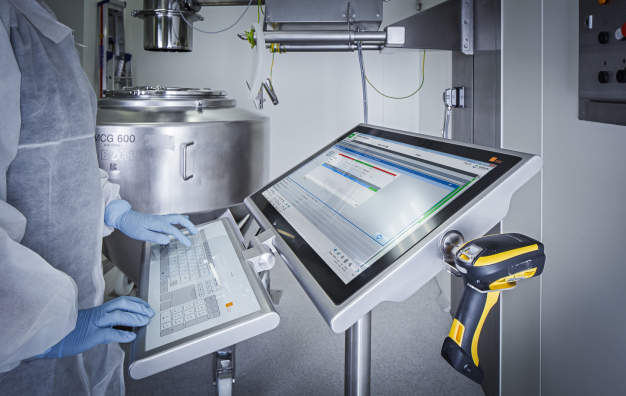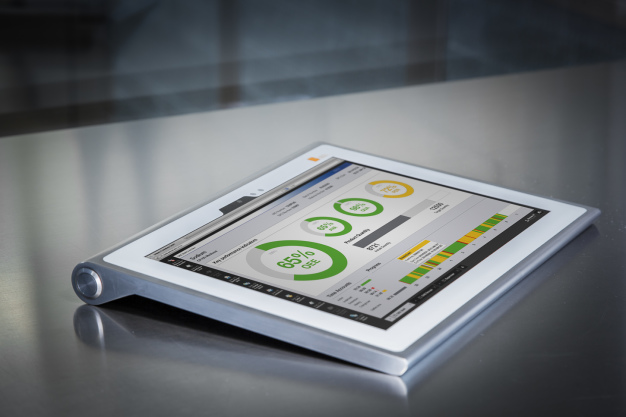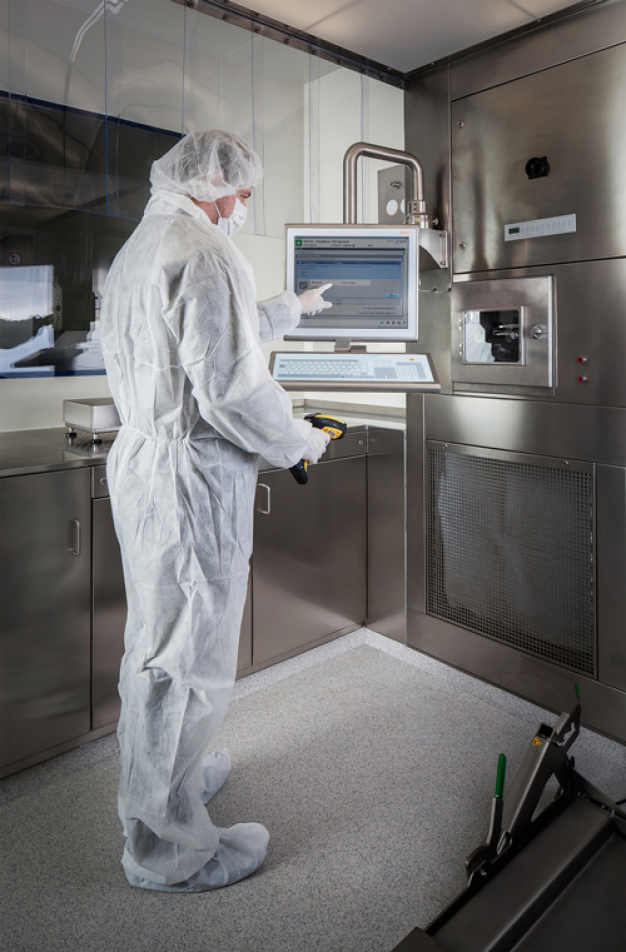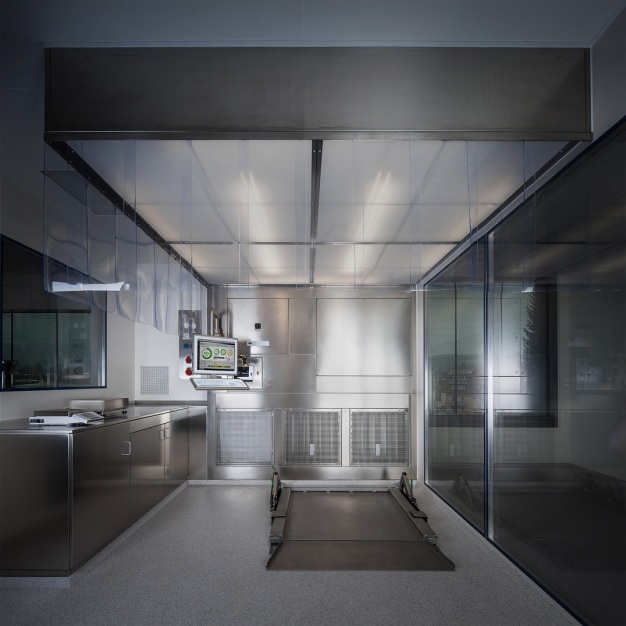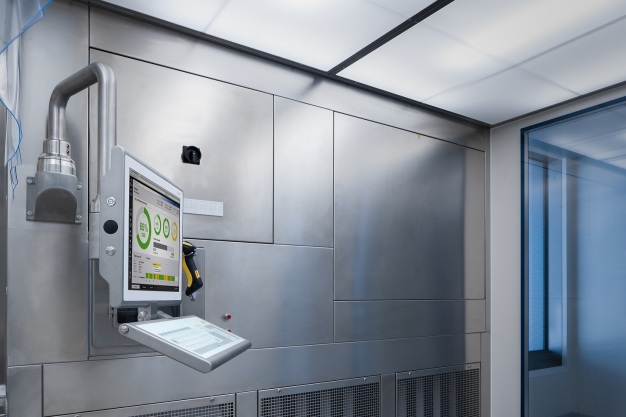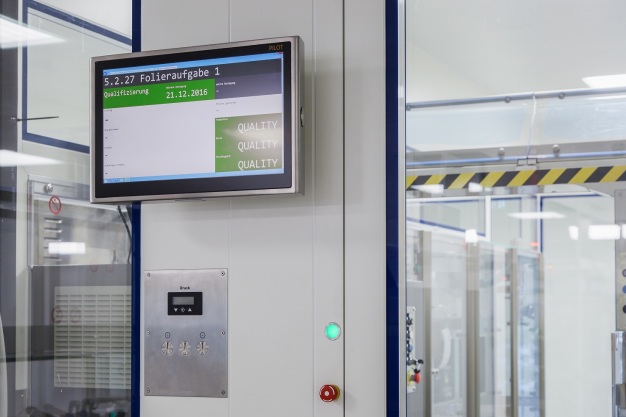- Furnishing & equipment
HMI Assembly Options in Cleanrooms
Consideration of different methods for HMI integration in cleanrooms for GMP-compliant planning of an optimized production environment
Preamble
Nowadays, it is hard to imagine process management and visualization in modern processing environments within the pharmaceutical and biotech industries without the use of Human Machine Interfaces (HMI). What’s more, the additional requirements for a paperless production process and biometric operator authentication increase the demands placed upon HMI systems in production environments.
For that reason, it is absolutely essential that HMI systems are integrated into the production concept and into the planning of process-related operational workflows from the outset. This integration process also involves planning how to position and assemble the systems, to ensure they are ergonomic for the operator to reach and operate.
When systems require integration into existing concepts and plans, the flexibility of the assembly solutions is paramount, as space is precious – especially when the field of application demands a high level of hygiene.
Assembly variants
If you consider the given specific requirements in different production areas within the pharmaceutical and biotech industries, it doesn’t take long to notice that almost all HMI systems are mounted to the wall or attached to the ceiling. This makes it easier for data connection and power supply cables to be routed in a hygienic manner and eliminates the need for cable glands in the assembly pipes. You seldom find HMI systems assembled on the floor, as routing cables via external cable glands is not generally accepted. This is because this type of assembly requires not only the cable glands, but also the routed cables or cable duct used to be cleaned.
However, if neither the wall nor the ceiling is able to take the load of the HMI, other solutions are possible. In this case, the heaviest part is designed to be assembled on the floor, but the cables are routed through the ceiling or wall. It may be a less elegant-looking solution, but it is practical and completely suitable for a cleanroom.
Wall assembly
Wherever circumstances allow, wall assembly is the easiest solution. However, due to the own weight of the HMI system, this does require mechanical reinforcement of the cleanroom wall. This is absolutely essential for the generated forces to be absorbed, which in turn ensures that the installation is safe and long lasting.
There are two basic types of wall assemblies: in-wall and on-wall assemblies.
In-wall assembly
This is the traditional assembly variant (see figure 1), used because older generations of HMI systems were designed with a deeper structure. It involves making a cutout in the cleanroom wall and defining a device-specific hole pattern with reinforcement. Normally, the device is then embedded with a front panel with welded stud bolts and screwed in from behind. The advantage of this solution is that it is easy to assemble and the device is flush with the wall, although the assembly frame may represent a potential dirt-collecting edge. For simple touch devices, this also continues to be a common assembly method – yet one that harbors several disadvantages.
This type of solution has to take the following points into consideration:
The hole pattern in the wall is specific to the device and model. If the device needs replacing, any modifications the manufacturer makes to the device can have significant invasive consequences in the cleanroom, as the assembly cutout in the cleanroom wall would have to be altered and adjusted to the new dimensions of the device.
If the device is assembled with a front panel and stud bolts, it must be possible to access the rear of the cleanroom wall, to have the option of replacing the device in the event of a repair.
However, this also means that, in the event of a repair, the cleanroom would have to be opened. In turn, this would also require carrying out the additional steps needed to reseal and clean the room. In short, a process that is both administratively complex and has a huge impact on the usage of the room.
There are solutions designed to minimize this sort of complexity: for example, by recessing an assembly frame into the wall and sealing this hermetically. However, this only reduces the outlay in replacing the device; it doesn’t address the problem of the dimensions of the cutout in the wall being specific the device.
In conclusion, this solution saves space, but the assembly method involves a huge amount of outlay, and costs the plant operator significant time and money if the device malfunctions.
On-wall assembly
The often-preferred method is assembling the HMI system onto the wall – as it is a more flexible solution (see figure 2). In recent years, this solution has gained in popularity over the in-wall assembly option, as advances in technology have resulted in devices that are smaller, more lightweight, and, in particular, slimmer. This makes the devices easy to clean and they require very little space.
This type of assembly also requires the wall to be structurally reinforced, in order to bear the generated forces. However, unlike with the in-wall assembly method, the positioning of the devices is more flexible: rather than having just one fixed position, it is possible to move the devices around using the various assembly systems. With one or more rotatable couplings, it is possible to rotate a device around its own axis. With the addition of a wall coupling, it is possible to pull the device out into the room or push it back again against the wall. It is also possible to position and move an HMI system as a duplex configuration (dual-screen display). This provides the operator with a huge amount of flexibility when viewing the content.
It should also be noted that these flexible solutions require cables to be routed internally, and for no cables to be visible externally. It is never easy to clean externally routed cables, and, as a result, they pose a contamination risk. When it comes to the couplings, it is essential that they have a rotation stop that limits the rotation to a maximum of 350°. This is needed to prevent the internal data and power supply lines from becoming twisted – and, thus, damaged.
In most cases, the assembly systems are standardized and, as a result, the devices on them can be exchanged. This makes the replacement process easier in the event of device discontinuation. Furthermore, with the on-wall assembly method, device supply lines can be routed into the cleanroom using a cable gland, which ensures the supply lines are hermetically sealed. This means that, in the event of an exchange, the cleanroom is opened and, consequently, cleaning it following the exchange of an HMI is not essential.
Mobile HMI
The in-wall and on-wall assembly methods are the traditional solutions and offer an excellent cost-benefit ratio in the case of cleanrooms that are more or less in permanent use. However, in many cases, cleanrooms are actually only used a few days a week, as preparations have to be made for the next production step and the room has to be cleaned for this. Consequently, the HMI systems are not in use for these tasks. These types of situations call for a state-of-the-art solution – mobile HMI systems (see figure 3).
The concept of powering a computer by battery, thus providing a mobile solution that can be used as and when needed, is not new. However, there are several things that need to be taken into account.
The most important requirement for the use of a mobile solution in a cleanroom to be successful is the connection to the network. Ideally, the WIFI should cover the entire production area, to ensure that data integrity is ensured at all times. Accordingly, for areas in which this is not possible or desirable, physical LAN connections should be provided via LAN sockets suitable for cleanrooms.
Given the fact that the mechanics of mobile solutions are more complex than fixed ones, another point to consider is the ability to clean the devices quickly and easily. If these have to be moved from one cleanroom to another, preventing cross-contamination is essential. As a result, a mobile solution should be designed for the cleanroom and comply with at least protection class IP65, to ensure that it meets suitability for cleaning conditions.
When using mobile solutions, taking the device out of the room to recharge the battery while production is in process is not desirable. Consequently, a long battery life is another essential criterion. It should be taken into account that a production shift can last for 8 hours in German-speaking regions, and up to 12 hours non-German-speaking regions. Over the course of its service life, a battery loses capacity, which is why you should never rely on the best-case battery performance. When trying to ensure that a battery will last throughout one or several shifts, you should assume a battery capacity of 75% as a basis, which should still be realistic after several years of use. Ideally, robust battery technologies (e.g. AGM – Absorbent Glass Mat) should be used which are characterized by high power and reliability.
When it comes to mobile solutions, it is also important to consider operator safety. Typical scenarios in production environments include a caster coming off the base of the device, the device hitting an obstacle, and the operator supporting themselves on the device. In each case, it has to be ensured that the device doesn't tilt or topple over. As a general rule, a mobile base with just four casters attached is not suitable for this.
Thanks to modern product designs, mobile solutions are no longer just available with one display, but also come as dual-screen display (duplex) solutions (see figure 4). This enables the operator to view several applications on the display at once.
Another development that has helped to make devices highly suitable for cleanroom use is not having to use charging cables, which means sockets in cleanrooms aren't necessary either. This is made possible by charging the batteries inductively. For this, one or several charging points are distributed around the cleanroom and are used to charge the device while it is in use (see figure 5). According to the current state of the art, the solution charges comparatively more quickly than cable-based charging equipment – depending on the version. Another advantage is that it saves space, as there is no longer the need for an allocated place to charge the mobile HMI.
Tablet PC
The tablet PC solution (see figure 6) is considered by many persons responsible to be the most cost-efficient solution for managing and visualizing processes in cleanrooms. A tablet PC is highly mobile, cost efficient and easy to replace.
However, this is a purely CAPEX (capital expenditure) point of view and is very rarely shared by production employees. In view of the differing perspectives, it is especially important to think about the application for which a tablet PC may be better or less well suited. Situations in which this still relatively new technology has been put into practice reveal that it is a particularly useful solution for maintenance, commissioning and when producing standard operating procedures (SOP). The mobility of a tablet is perfect for these applications.
Other applications, such as operating a manufacturing execution system (MES) or a distributed control system (DCS) require the ability to input data. Inputing data on a tablet PC is done via an on-screen keyboard, which takes up space on the display. Consequently, the operator no longer has a clear overview and the tablet PC becomes a hindrance and a risk factor in the production process.
Permanently installed and mobile HMI solutions can be fixed into one specific position, which enables the operator to use both hands for their usual work tasks. In the case of a tablet PC, either a special shelf has to be created, or the operator has to continue carrying the device. Having to continue holding the device makes scanning processes with a tablet PC cumbersome compared with a hand scanner, due to the lack of ergonomics. On the other hand, a link with a hand scanner makes inputting data on a tablet difficult, as both hands are occupied.
The general usefulness of tablet PCs in cleanrooms also has to be considered. A product for private end users is suitable for use in a cleanroom only with the help of special auxiliary solutions, such as placing it in a stainless steel housing. If a tablet PC isn't protected, then its essential cleaning suitability is either not guaranteed, or is only possible with considerable outlay, as even open ports (Micro USB), for example, have to be cleaned meticulously. The extent to which it is possible to use standard cleaning products from the pharmaceutical and biotech industries then has to be determined for each individual case.
Another point that is often overlooked is the product life cycle of a commercial product. Tablets are subject to shorter life cycles than an industrial product. As a result, it is likely that after the successful testing, certification and procurement processes, the chosen tablet is replaced by the next model.
The final point that needs to be resolved is where and how to recharge the tablet PCs. Depending on the application, the battery life of a tablet PC in normal use probably would not last for an entire shift. If the device is to be charged in the cleanroom, it must be possible to clean the actual docking stations, and a charging place for the tablet PCs has to be provided. If the devices are to the recharged outside of the cleanroom, the tablet itself has to comply with the requirements for GMP-compliant cleaning suitability, so that it is easy to take it in and out of the cleanroom.
LEAN production
Another point that is often given only little thought when selecting and positioning the HMI devices is planning the HMI as an integral part of a LEAN production process. If you compare the spaghetti diagram (see figure 7) for permanently installed HMI systems and mobile HMI systems, inputting data at the location where the data occurs is significantly more effective, and also makes the process leaner. If this procedure is combined with biometric operator authentication, it significantly improves productivity.
Environment health & safety (EHS)
Considering different assembly options from an EHS perspective involves thinking about aspects such as device safety, device suitability for cleaning, environmental friendliness of the materials used and, in particular, ergonomics. It is important that devices go further than meeting the current state of the art; they must also be produced in a safe and sustainable manner. With regard to sustainability, the use of lead-free components and solder has now become state of the art, and manufacturers also have to comply with the REACH regulation (Registration, Evaluation, Authorisation and restriction of CHemicals).
In terms of health, cleaning the device using production-specific cleaning solutions must be easy and pose no problems; it must be facilitated by the design of the device, material characteristics and surface structure. A roughly ground stainless steel surface is not suitable in this case, and care should also be taken in the design, so as not to enable liquid and dust to collect easily on flat surfaces. Only if these measures are taken can it be ensured that operators do not come into contact with contaminated surfaces at a later point and that highly active substances do not accumulate on top of these surfaces.
When it comes to safety, particular attention must be paid to avoid 90° angles in the design of the device wherever possible, to reduce the risk of the operator injuring themselves on the housing. For optimum device use, keyboards have to stick out from the front of the device, but in many instances this increases the risk of collision with the operator. If keyboards can be swung away out of the pathway of the operator, this is the preferred solution. A mobile solution has to have at least 5 casters, to ensure it doesn't tip over in the event that a caster comes off, and device top-heaviness is also a significant problem if a device is wheeled over ramps or bumps into obstacles.
Special solutions
Height-adjustable HMI
In many instances, a height-adjustable HMI assembly solution is considered to be an ergonomically suitable design. This is a useful solution for older HMI display devices, as their angle of view means operators can only view the device directly from the front. More recent display technologies, such as in-plane switching (IPS) allow you to view the display from a 178° angle. Furthermore, when combined with optical bonding (the gapless connection between display, touch and front glass) – as found on smartphones and tablet PCs – the display is significantly brighter, clearer and has better contrast. These technologies make it possible to forgo a height-adjustable assembly. They also considerably improve suitability for use in a cleanroom, due to the fact that mechanically height-adjustable solutions always have moving parts that interlink with each other. The cleaning suitability of this type of solution must always be assessed very critically, as normally it doesn't concern a closed system in accordance with the IP65 protection type.
Building management systems
Building automation doesn't just concern the decentralized management of an air-conditioning system; it also concerns designing a comprehensive solution to ensure that energy use, access control and set-up of control capabilities for monitoring ambient conditions are as efficient as possible. Due to the paperless documentation and network requirements from Pharma 4.0, the pharmaceutical and biotech industries are faced with additional requirements in terms of building management. In this case, the user interface is an HMI, normally with a small display and limited computing power, and which is connected to a central server via the network. From here, it makes requests for the information to be displayed and, if necessary, passes on the details entered by the operator. For these simple display tasks, it is sufficient to use a display that can be operated when in cleanroom protective clothing and has a network connection, plus, ideally, an integrated power supply via Power over Ethernet (PoE). This enables assembly and cabling work to be kept to the bare minimum. As it is the server that supplies the computing power, it is possible to forgo the use of powerful hardware and it is advisable to use a thin client. Ideally, it should be possible to assemble these displays to the cleanroom wall without using reinforcement, such that they are flush with the surface of the wall, thus guaranteeing IP65 protection. In the event of device malfunction, it must be possible for the operator to remove the device by lifting it towards themselves.
Afterword
The requirements placed upon HMI systems in production environments within the pharmaceutical and biotech industries are diverse and challenging. As a result, the solutions have to be flexible and meet the complex requirements of good manufacturing practice (GMP) and its associated qualification. The needs of the operator should be just as much a priority as the actual suitability of the device for the production environment and easy cleaning of the devices. Depending on the scope of requirements, an HMI is no small investment, and is something that, with advanced planning and incorporation of the manufacturer in this process, ensures the best possible return on investment (RoI).

Systec & Solutions GmbH
Wilhelm-Schickard-Str. 9
76131 Karlsruhe
Germany
Phone: +49 721 663510
email: talk@systec-solutions.com
Internet: http://www.systec-solutions.com





